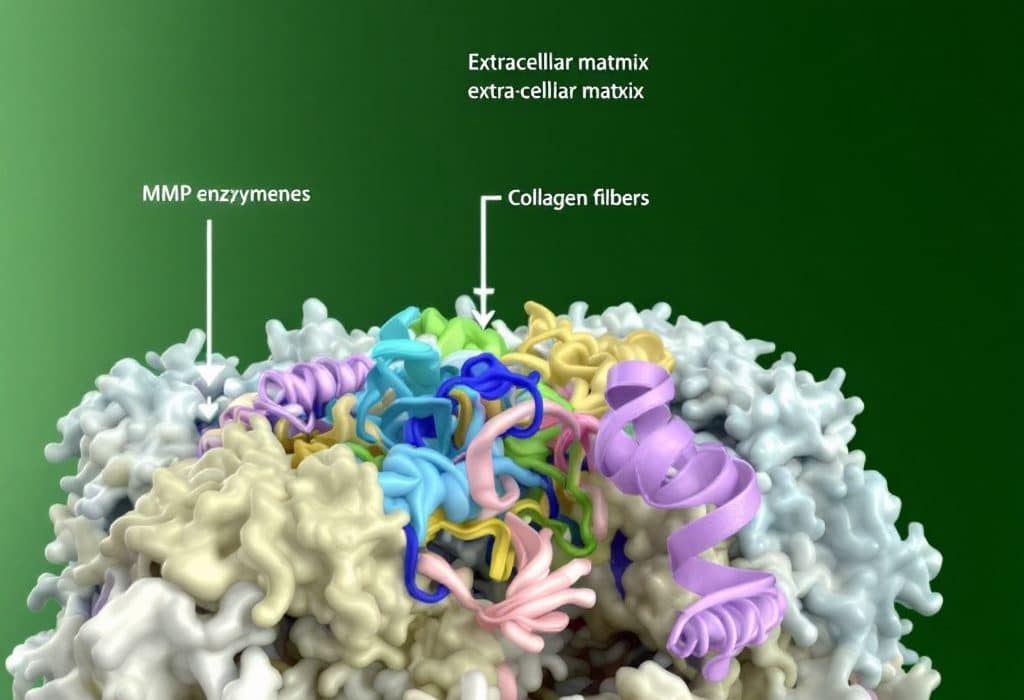Ever thought about what happens beneath your skin as you age? Sure, we all worry about wrinkles and sagging skin — but what’s really going on at the cellular level? Alright, let’s take a dive into an intriguing topic, matrix metalloproteinases, commonly known as MMPs. They’re like the secret agents working behind the scenes, orchestrating various processes within our bodies, particularly those related to aging.
What Are Matrix Metalloproteinases?
Matrix metalloproteinases, or MMPs, are a vast class of enzymes that play a pivotal role in remodeling the extracellular matrix (ECM). Sounds technical, right? But stick with me. The ECM is basically your body’s support system, composed of proteins like collagen that hold your cells in place. Think of MMPs as the handy workers with a toolbox, ready to break down these proteins and tidy things up or make adjustments when needed. This meticulous balance is crucial, much like the role of ceramides in skincare to maintain the skin’s barrier integrity.
How Do MMPs Impact Aging?
Before we get too deep, here’s the big question: How do these little enzymes affect aging? As the body ages, the activity of MMPs ramps up. That’s not a problem in itself; MMPs are crucial for maintaining the balance of breaking down and building up ECM components. The catch? Too much MMP activity can lead to undesirable outcomes, like the breakdown of collagen in your skin.
Now, why should collagen matter to you? Mainly, it’s one of the key elements keeping skin firm and elastic. Remember back when you could smile all day without a crease left behind? Yep, that’s thanks to the spunky fibers of collagen. Overactive MMPs, however, can send your once-peppy collagen into a slump, contributing to those lines and wrinkles. This is akin to how peptides in skincare work to support skin structure and mitigate these effects.
A Deeper Dive into Enzyme Activity

Okay, picture this. MMPs are acting up, collagen is crumbling, and you’re there wondering what all the fuss is about. Here’s where enzyme activity gets more fascinating. Not all MMPs function the same way; they form a diverse group with specific targets and behaviors. Currently, researchers have identified around 25 different MMPs, each with unique properties and functions. This diversity is comparable to the role of skin lipids, which are essential yet varied in their functions across the skin’s ecosystem.
Why You Should Care About Enzyme Activity
Understanding enzyme activity gives insight into the biological processes linked to both tissue health and aging. MMPs contribute to wound healing, pregnancy, bone growth, and more. Kind of like when you plant seeds (the enzymes) and hope for a blooming garden (healthy tissue), their balance is critical. Similarly, hyaluronic acid is a key player in maintaining skin hydration and suppleness.
MMPs at a Glance
| MMP Type | Main Function | Associated with Aging Effects |
|---|---|---|
| MMP-1 | Collagen breakdown | Skin aging, wrinkle formation |
| MMP-2 | Gelatinase which degrades gelatin and type IV isomers | Tissue remodeling, skin elasticity loss |
| MMP-9 | Similar to MMP-2 but often involved in inflammation | Inflammatory aging processes |
Balancing Act: The Good and the Bad
Getting the balance right? That’s the tricky part. When MMP activity surpasses what’s necessary, it disrupts the harmony. Think of it as letting weeds overrun your garden – it might start small, but soon enough, the entire system feels the impact. Excessive collagen breakdown weakens the structure and function of tissues, which can fuel the visible signs of aging and even promote conditions like arthritis. Just as ingredient layering in skincare can enhance or disrupt skin health when not balanced properly.
Why Do MMP Levels Increase with Age?

Aging is like a winding road full of surprises, and part of the journey involves an increase in oxidative stress and inflammation, factors that can skyrocket MMP activity. Inflammation, often described as the industry’s “inflam-aging,” is a chronic state that persists over time, nudging your body into a peculiar cycle of damage and repair. It’s like your body becomes hyper-alert, unnecessarily wearing itself out — and MMPs are the middlemen here, caught between generating necessary repairs and potentially harming skin integrity. This can be likened to the effects of humidity on aging, which can exacerbate these processes.
Proton-Coupled Angles: MMP Inhibitors and Their Role
Enter MMP inhibitors, the unsung companions in this complex dance. Every superhero has a nemesis, and MMPs are no different. Nature provides several MMP inhibitors to keep everything in check, naturally called tissue inhibitors of metalloproteinases (TIMPs). They attach themselves to MMPs like glue, controlling their activity and preventing excessive hurt to the ECM.
Enhancing Skin Health: Practical Strategies
With all this buzzing activity below the surface, how can you interactively manage MMP activity? Let’s talk practicality with some down-to-earth steps. Understanding the role of ceramides in maintaining skin’s natural defenses is crucial in this process.
- Healthy Lifestyle Choices: Don’t underestimate what a solid night’s sleep, good hydration, and balanced diet can do. Fresh fruits and vegetables bombarded with antioxidants and anti-inflammatory components might just guard against surges in oxidative stress which typically ramp up MMPs. Similarly, incorporating glycosaminoglycans in your diet can bolster skin hydration.
- Skincare Routine: Seeking products containing retinoids and peptides can bring skin elasticity back into the fold. Retinoids are excellent for boosting collagen production—kind of like hitting ‘refresh’ on your skin surface. Additionally, focusing on skin barrier lipids can enhance overall skin health.
- Regular Exercise: Consider this your go-to remedy. Exercise not only keeps you fit but might also positively impact levels of oxidative stress and indirectly manage MMP activity. This is crucial, much like maintaining proper cellular hydration through aquaporins.
Circling Back: MMPs Beyond the Skin

Alright, it’s easy to laser-focus on MMPs’ role in skin aging, but they have influential roles in so many biological processes—bone remodeling, cardiovascular health, and response to brain injuries. Indeed, it’s a universal matrix that scales broadly over human health, shifting the paradigm for diseases and therapeutic treatment. Understanding these roles enhances our approach to ingredient layering for optimal skincare results.
An Invitation for Further Exploration
If there’s one thing to take away from this casual science stroll, it’s this: MMPs might seem like a minute piece of nature’s grand puzzle, but they’re undeniable players in establishing and adjusting the fine line between health and aging. Research continues to probe their mysteries, advancing toward interventions that could one day push the ‘pause’ button on age-related degeneration. Imagine that!
To wrap up, understanding the matrix of MMPs isn’t about fear—it’s about awareness and choice. Recognizing how they operate allows each of us to make informed decisions about managing our body’s aging process. And while we may not be able to stop aging entirely, taking action and focusing on the balance between breakdown and regeneration is a timeless strategy for maintaining vitality.
Take notice, give yourself the time, and embrace the tidbits science has gifted us with learning how you and your MMPs can co-exist in harmony through time. If curiosity sparkles and you feel compelled to dive deeper into the subject, trust me on this one, there’s always another layer to uncover.
Frequently Asked Questions
What role do Matrix Metalloproteinases (MMPs) play in the aging process?
MMPs are a family of zinc-dependent endopeptidases that play a crucial role in the remodeling of the extracellular matrix (ECM) during the aging process. They degrade various ECM components such as collagen, elastin, and fibronectin, which can lead to tissue deterioration and contribute to age-related diseases like atherosclerosis, hypertension, and neurological disorders[1][2][5).
How do MMPs contribute to arterial aging and associated diseases?
MMPs, particularly MMP-2 and MMP-9, are involved in arterial remodeling during aging. They promote the degradation of ECM components, leading to arterial stiffening, intimal-medial thickening, fibrosis, and calcification. This process is associated with increased blood pressure and the development of hypertension and atherosclerosis. Inhibition of MMPs has been shown to alleviate these age-associated arterial changes[2).
What is the impact of MMPs on skin aging?
MMPs are pivotal in skin aging, especially in response to UV radiation. They degrade collagen and other ECM components, leading to skin photoaging characterized by wrinkles, epidermal thickening, and dyspigmentation. The upregulation of MMPs by UV radiation contributes to the breakdown of the skin’s ECM, accelerating the aging process[5).
How do MMPs affect muscle aging and satellite cell function?
MMPs, such as MMP-10, play a significant role in muscle aging by modifying the muscle ECM. The loss of MMP-10 can lead to premature aging features in muscles and impair the repair function of satellite cells. This disruption in ECM remodeling affects the niche of satellite cells, contributing to muscular aging and senescence[4).
References- The Role of Matrix Metalloproteinases (MMP-2 and MMP-9) in … PMC7222606.
- Matrix Metalloproteinases Promote Arterial Remodeling in Aging … Hypertensionaha.114.03618.
- Loss of the matrix metalloproteinase-10 causes premature features … Frontiers in Cell and Developmental Biology.
- Matrix Metalloproteinases on Skin Photoaging – PMC PMC11626319.


